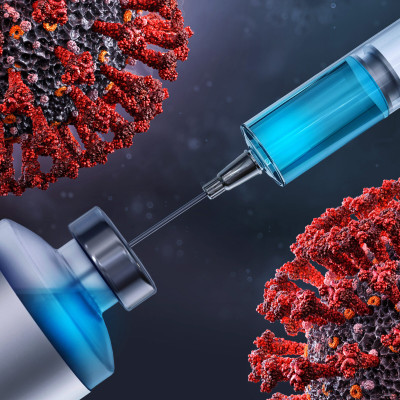
2021-05-22
Visited : 2828
The development of nano-biosensors and nanoparticle-based vaccines and medicines has opened a new path toward better management of the coronavirus disease 2019 (COVID-19) pandemic. In a recently published article in the journal ACS Biomaterials Science &; Engineering, scientists have reviewed recent advancements in nanotechnology-based diagnostic and therapeutic interventions against human coronaviruses.
Background
Severe acute respiratory syndrome coronavirus 2 (SARS-CoV-2), the causative pathogen of COVID-19, is an enveloped, single-stranded, positive-sense RNA virus, which shares more than 50% sequence similarity with other lethal members of the human coronavirus family, including SARS-CoV and Middle East respiratory syndrome coronavirus (MERS-CoV).
SARS-CoV-2 primarily spreads from person to person via large respiratory droplets. However, some recent studies have indicated the possibility of airborne transmission via small respiratory aerosols.
Infection with SARS-CoV-2 initiates with the binding of viral spike protein to host cell angiotensin-converting enzyme 2 (ACE2) receptor. Upon receptor binding, the spike protein is proteolytically activated by the host cell protease TMPRSS2, leading to dissociation of the spike S1/S2 subunit and fusion of the viral envelope with the host cell membrane.
Being a respiratory virus, SARS-CoV-2 primarily affects the upper respiratory tract and causes mild to severe pulmonary illness. However, the virus can infect other vital organs and cause a wide range of clinical complications, including cardiovascular, neurological, gastrointestinal, hepatic, and nephrological disorders.
Nanomaterials in the diagnosis of viral infection
Molecular techniques such as reverse transcription-polymerase chain reaction (RT-PCR) are considered the gold standard for diagnosing SARS-CoV-2 infection. However, the accuracy, sensitivity, and specificity of RT-PCR strictly depend on the genetic consistency of the virus. The emergence of novel mutations in the target viral component can potentially affect the diagnostic efficiency of RT-PCR.
For image-based and clinical diagnostic of COVID-19, nanomaterials are emerging as promising substrates because of their unique optical, electronic, magnetic, and mechanical properties. Nanomaterials that have been proposed for viral detection include metal, silica, and polymeric nanoparticles, quantum dots, and carbon nanotubes.
Nanobiohybrid platforms
Nanomaterials can be conjugated with specific viral components, such as nucleic acid or protein, to develop nano-bio hybrid tools to detect viral infection. In this approach, multivalent nano-based probes are used for signal transduction.
Colorimetric analytical devices with silver nanoparticles as colorimetric substrates have been developed to detect MERS-CoV nucleic acids. Similarly, gold nanoparticle and quantum dot-based immunosensors have been developed to detect Avian coronavirus infection. Such immunosensor-based methods exhibit higher accuracy and sensitivity and faster turnaround time than ELISA.
To detect Avian coronaviruses, immunochromatographic strips have been developed using conjugates of viral spike-specific monoclonal antibody and colloidal gold as tracers. Similarly, lateral flow assays have been developed for accurate SARS-CoV-2 detection. In these assays, a paper strip is coated with conjugates of gold nanoparticle and virus-specific antibodies in the first line. In the second line, capture antibodies are used for coating. For detection, biological samples are placed on the strip, and proteins of interest are placed on the membrane. After binding of viral antigens to the nanoparticle–antibody conjugates, the entire complex flows through the strip and is immobilized by the capture antibodies in the second line. This leads to the appearance of a colored line.
To monitor spike – ACE2 interaction, an energy transfer system has been developed using recombinant spike RBD conjugated with fluorescent quantum dots, gold nanoparticles, and cells expressing GFP-tagged ACE2. Similarly, an advanced field-effect transistor biosensor has been developed using graphene sheets conjugated to a specific anti-SARS-CoV-2 spike antibody. This biosensor is used for ultrasensitive sensing and detection of SARS-CoV-2 antigens.
Microfluidic devices
In microfluidic devices, a polymer-, glass-, or paper-based chip is fixed with reaction chambers and microchannels. Using capillary, vacuum, or electrokinetic forces, this device mixes and separates liquid samples.
Recently, a smartphone-based microfluidic platform has been developed for colorimetric detection of antibodies against HIV infection. This platform is composed of ZnO nanorods and polydimethylsiloxane.
Nanomaterials in treatment of viral infection
Nanomaterials, such as silver colloid, titanium dioxide, and diphyllin nanoparticles, are considered promising antiviral agents and drug-delivery platforms for the effective management of coronavirus infection.
Nano-based gene therapy
Small interfering RNAs (siRNAs) are highly efficient in reducing the replication of RNA viruses, such as coronaviruses. The efficacy of siRNA-based treatments strictly depends on specific targeting of the viral sequence of interest and targeted cellular delivery of therapeutic siRNA. In this context, nontoxic, biocompatible nanocarriers composed of polymers, lipids, polymer/lipid hybrid nanoparticles, nanohydrogels, silica, dendrimers, iron oxide nanoparticles, or gold nanoparticles are considered as promising siRNA-delivery platforms. These nanocarriers can improve siRNA stability by preventing enzymatic degradation.
For inhalable antiviral siRNA loading and aerosol-based delivery of antiviral siRNA in the lungs, polymer/lipid nanocarriers have shown promising outcomes. Similarly, Cholesterol-conjugated lipid nanoparticles have shown high potency in delivering mRNA-based COVID-19 vaccines.
Nano-based immunotherapy
Nanoparticulate forms of immunomodulatory agents have shown promising outcomes in terms of modulating the functions of immune components and reducing immunomodulation-related toxicity. In addition, nanoparticles, such as dendrimers, liposomes, carbon nanotubes, polymer-based materials, and inorganic nanoparticles, can be incorporated with several antigens for a more robust activation of the immune system.
Nano-based vaccines
Antiviral nanoparticles have been used as potential immunostimulatory agents for vaccine development. For example, gold nanoparticles conjugated with swine transmissible gastroenteritis virus have been used to activate macrophages, induce interferon production, and increase anti-coronavirus neutralizing antibody levels in vaccinated animals. Similarly, conjugates of ribonucleic acid and ferritin-based nanoparticles have been used as molecular chaperons to develop a vaccine against MERS-CoV. The vaccine has been shown to induce a strong T cell response and promote interferon production.
Currently, nanotechnology is playing an increasingly important role in antiviral therapy for coronaviruses. Nanomaterials have been developed specifically to improve the delivery of biotherapeutics across physiological barriers. A broad range of potential nanodevices, such as nanosensors, nano-based vaccines, and smart nanomedicines, offers great hope for combating current and future mutated versions of coronaviruses.
Read the original article on News Medical.